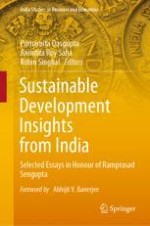2021 | OriginalPaper | Chapter
Embracing Natural Resource Accounting in India: Some Reflections
Author : Shalini Saksena
Published in: Sustainable Development Insights from India
Publisher: Springer Singapore
Activate our intelligent search to find suitable subject content or patents.
Select sections of text to find matching patents with Artificial Intelligence. powered by
Select sections of text to find additional relevant content using AI-assisted search. powered by
